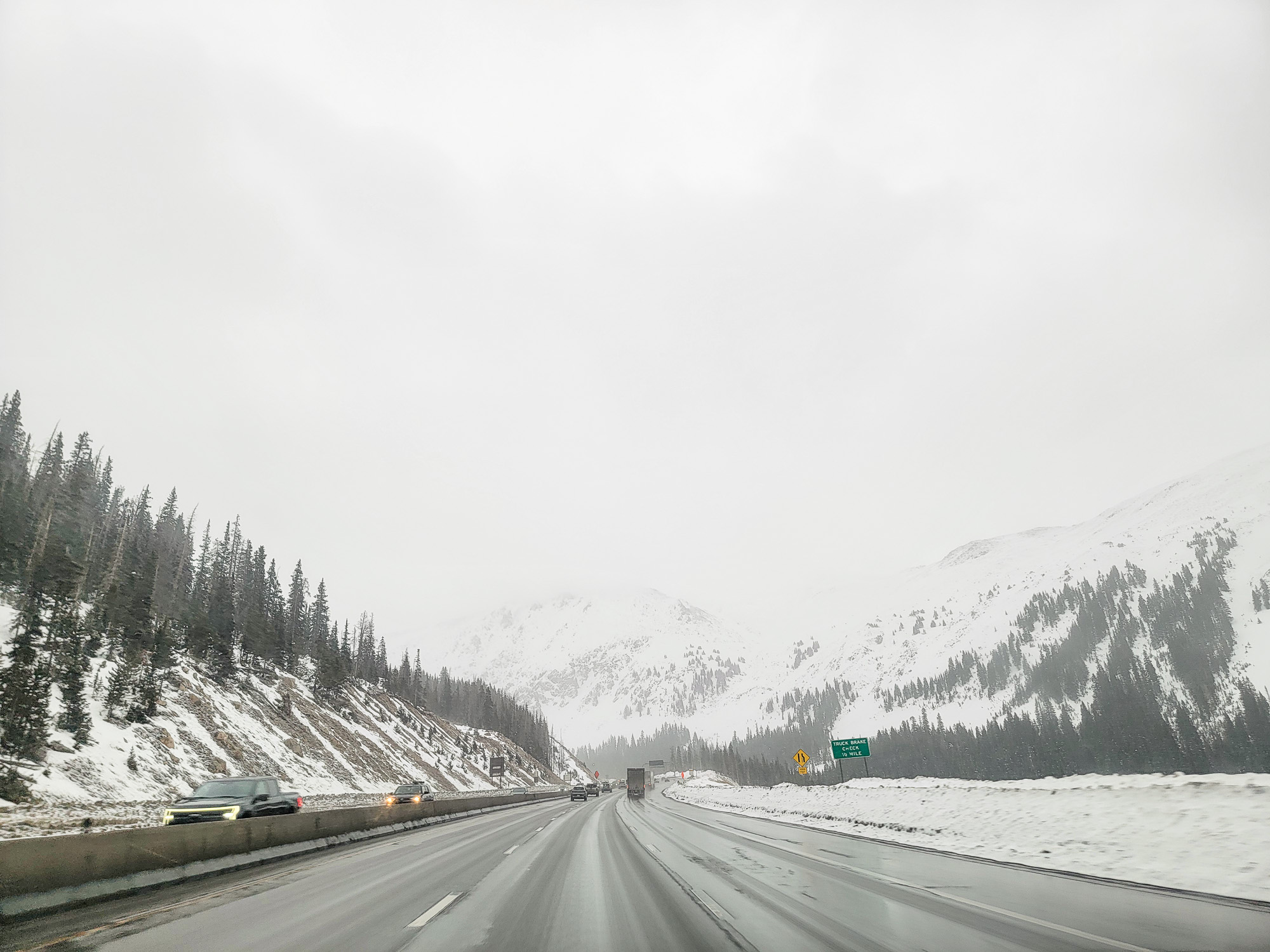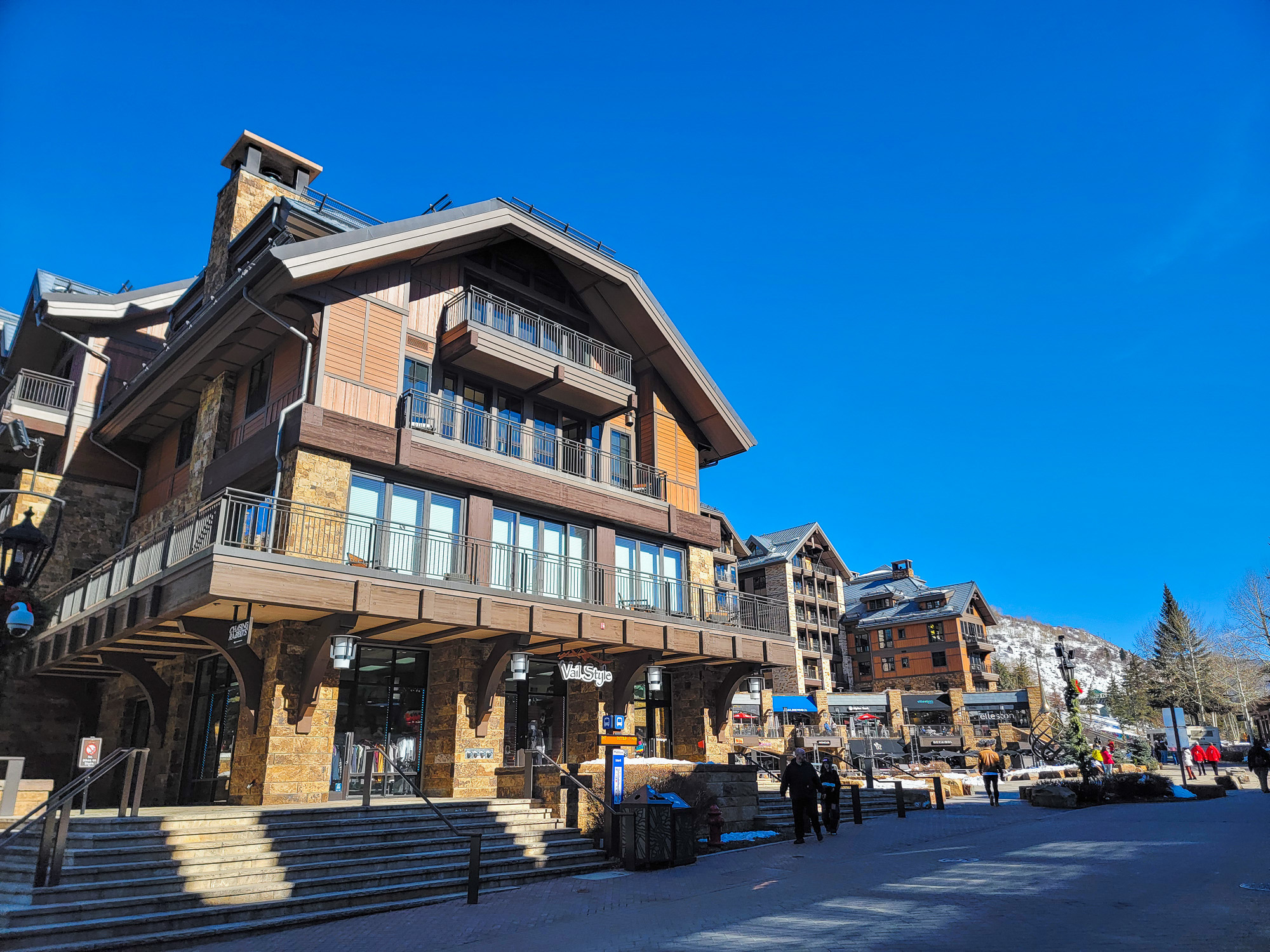Published by Jeremy. Last Updated on February 22, 2024.
Disclaimers: Our site uses demographic data, email opt-ins, display advertising, and affiliate links. Please check out our Terms and Conditions for more information. Listed prices and attraction details may have changed since our visit and initial publication.
When it comes to driving in the United States, the vast majority of the time we simply don’t think about it because getting around is incredibly easy. Rent a car, pick it up, and go without hesitation.
On the surface, driving to Vail in the winter seems a lot like that. If you fly into Denver, you pick up a car, drive west on I-70 for an indeterminate period of time (for reasons we’ll talk about later), get off the highway, and you are, quite literally, there. You are driving in the mountains, but it is on a multi-lane highway the entire way.
But throw in potentially hazardous snow conditions, the limited (and expensive) parking in Vail proper, the laws for driving in the mountains during the winter, and, of course, opportunistic rental car companies hoping you’re not the wiser, and there is a lot to consider when driving to Vail in the winter indeed.
So, let’s break down some of the important things to know for what should otherwise be an easy drive!
✈️ Book Your Next Trip
- • Planning a trip? Find a flight deal.
- • In need of a room? Check out hotel and apartment prices.
- • Taking a cruise? Find a cruise itinerary for your journey.
- • Don't overlook picking up a rental car or day tours as well!
Driving in Vail is Easy, Driving To Vail is the Challenge

When it comes down to it, driving in Vail is practically a non-issue. The town is quite small such that you’re never really more than five minutes from anything, and, even better, Vail makes it so easy for you to not drive at all!
Ultimately, Vail has a strong desire to minimize the number of cars that come into the area for winter. They have limited parking, inflated rates (see: exceptional demand), and offer just about every incentive imaginable to try and get you to not utilize a car during your stay, even offering frequent buses completely free throughout the entire city.
Throw on free shuttles from hotels that are a bit further away from the villages (which are walking distance to the gondolas), and the need for a vehicle here drops dramatically unless you have other plans like driving to Glenwood Springs for a hot springs day or going elsewhere on your itinerary beyond simply heading back to an airport for departure.
The bigger problem here is if you choose to drive to Vail from Denver.
First is because you will be driving in the mountains. This means winter weather is amplified and can be far more treacherous than driving in or near a city.
Vail Pass is one of the more notorious spots for inclement weather, as its position at nearly 11,000 feet above sea level and steep roads makes it a hot spot for poor conditions and all of the wrecks and delays associated with it. That 90-minute drive from Denver can easily become two, three, six, eight hours, or more with just a little bit of snow and a handful of wrecks. Yes, it can be that bad, and all it takes is one or two inexperienced drivers to ruin it for everyone else.
They may even close the pass entirely if conditions get extremely bad, too!
Second, to help alleviate some of these driving risks, there are laws that take effect during the winter that you may not be aware of. The biggest of which is that it is illegal to drive a vehicle that is not either equipped with either four-wheel/all-wheel drive (4WD or AWD) or snow/all-weather tires. In either case, each car must have a minimum tread depth of the tire, too. Without this, chains or alternative devices may be required.
- As with all things, we are not legal experts. Verify this with external sources before booking your rental car.
It is worth noting that the car requirements here are considered secondary offenses. Police generally do not enforce this law unless it is involved with another factor- you getting pulled over for speeding, your car breaking down and needing assistance, or, more likely, if you are part of a wreck.
As such, while we know that many travelers simply ignore this rule, the risk is on you here as mountain driving without the proper vehicle and/or tire setup is incredibly dangerous and, depending on the weather, quite stupid.
Finally, we had a bit of bad luck with our trip as Vail was forecast to receive upwards of a foot of snow on the day we were meant to drive back to Denver. As we were worried about delays, or possibly getting stuck for another night with an obscene hotel fee, we decided to leave Vail one day early when the snow was just starting.
Even though they had barely received an inch, people were already driving like it was a full-on blizzard. They ended up getting about 15″ of snow that night, but, thankfully, the traffic was never more than 2 1/2 to 3 hours. That said, one more wreck and it could’ve been much, much worse.
So, while planning for driving in winter weather is always something worth keeping in mind, you may also want to remain flexible with your overall plans, too. We spoke to far too many people who have left a ski trip early simply because they wanted to make it back to Denver safely over the years. It is always a risk!
Car Rental Companies Are Sneaky
One tangential element to the car and tire laws that we find particularly unsettling is that rental car companies are more than happy to be vague about these rules.
You would think that rental car companies that operate in winter destinations would have these tires and/or AWD vehicles as standard for the cars in their inventory. Or, at a minimum, their websites would show this as a prominent warning. But they often don’t. This is not a problem with USA-based companies alone and is something we’ve seen time and time again all over the world. (Seriously, make it a common practice every time you rent a car in winter to look up if there are any seasonal laws or restrictions.)
The very first thing we saw when we walked into our rental car company at the Denver airport was a big sign saying, “We cannot guarantee 4WD/AWD vehicles or winter tires”. We saw that same sign repeated several more times in the queue. Then, one of the first questions we received from our rental agent was, “Are you heading up into the mountains?” Yes, they do this partly because of the law. But also because if you rented a car without AWD/4WD/all weather tires, they are obligated to force you to upgrade- often to the tune of hundreds of dollars based on whatever inventory they have remaining at the time.
Would it be cheaper to simply book the right car upfront? Most likely. But most services do not feel helpful at all until it is far too late and you are stuck with whatever option is presented to you.
Of course, there is another option here even if it is an unethical one- many people just outright lie. But we obviously cannot condone that given the risks associated and the fact that driving without a proper vehicle setup is, again, illegal. So don’t do that.
But even though that is one consideration that people can and do decide to do, if you have any form of ski gear with you, such as a ski case, your intention of going up to the mountains will be incredibly clear to anyone at the desk. This was the case of a person in front of us who was hit with an unexpected bill because he was none-the-wiser to the requirements and his ski case gave him away.
So, do yourself a favor, and book that AWD/4WD vehicle at the start, lock in a cheaper rate, and avoid the risks altogether. It just isn’t worth it to play fast and loose with these rules- for safety and money reasons!
Fly Into Vail or Take the Shuttle if You Can
Finally, we’d be remiss if we didn’t share an option that you may want to consider- not driving at all.
As mentioned above, Vail makes it incredibly easy to get around most all of town, for free, and is really trying to incentivize visitors to not bring a car. So, if your itinerary allows, don’t get a car at all!
There are a few ways you could potentially make this work. One would be flying into Vail, which has direct flights from many major cities all over the country in winter. Even when factoring in slightly inflated prices, or a layover, routes for us didn’t seem that much more expensive than flying into Denver. So if you do not want to spend any time in Denver, cut out the drive (plus weather risks), and the car costs, at the expense of a slightly more expensive plane ticket.
Another option would be to take the Epic Mountain Express shuttle from Denver which picks up and drops off straight from the airport. We have to admit that this one would have cost more for the two of us than having our car for a week with gas, so it did not make too much sense in the grand scheme of things (partly because we also wanted the car to explore some of Denver). But for those who are solely skiing without going anywhere else, could be a suitable alternative as well.
Overall, while driving to Vail and within town should be quite easy, there are some elements to keep in mind like the risk of severe weather, the laws, and of course the added costs of getting an appropriately rated vehicle. Whether or not the alternatives make sense is up to your own specific case, but know all of these going in and you will be less likely to have an unexpected surprise on you when you arrive!
Have you ever had any issues with a car heading to Vail? Comment below to share!
About Jeremy

About the Author: Jeremy is a full-time travel writer based in Pittsburgh and primary author of this site. He has been to 70+ countries on five continents and seeks out new food, adventure activities, and off-the-beaten-path experiences wherever he travels.

It was abt, 1996, I was in school for a CDL in trucking. But my trainer was frequently asleep while I drove. We were headed ro Vail from the west, the power steering went out, had to wake tat crazy trainer up, she was able to muscle that truck into Vail. Thought my time had come to pass on.
Oh geeze that sounds terrifying. Those mountains are no joke!